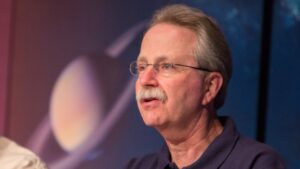NASA astrophysics director to step down
By Jeff Foust

WASHINGTON — Paul Hertz, who has led NASA’s astrophysics programs for nearly a decade, will step down by the end of the year to pursue his “next challenge” at the space agency.
During a town hall session of the 238th Meeting of the American Astronomical Society (AAS) June 7, Hertz took attendees by surprise when he said it was time for someone new to serve as director of the astrophysics division of NASA’s Science Mission Directorate.
“It is my personal belief that 10 years is long enough for a single person to guide an organization, a program and a community,” he said. “Thus, around the end of the calendar year, I’m going to step down as director of NASA astrophysics and move on to my next challenge at NASA, which I have not yet identified.”
Hertz became director of NASA’s astrophysics division in March 2012. He has been at NASA since 2000, serving as a senior scientist and manager, including chief scientist of the Science Mission Directorate.
Hertz won widespread support in the agency and the astrophysics community for running a broad program that ranges from flagship-class space telescopes to Explorer-class small missions and, more recently, smallsat and cubesat spacecraft. He also worked to bolster funding for research and analysis programs that support scientists in the astrophysics field.
“If I wanted to describe him with one word, I think of him as the oracle,” said Thomas Zurbuchen, NASA associate administrator for science, of Hertz at the town hall meeting, praising him as someone who “provides wise and insightful counsel or even prophetic predictions.”
“After spending a fair fraction of my professional career over the last 10 years working with Paul in a variety of capacities, I can say with some authority that he has been a truly outstanding leader of NASA’s [astrophysics] division,” tweeted Scott Gaudi, a professor of astronomy at Ohio State University.
Hertz said this was a “really good time” to have someone else lead the astrophysics division, noting the impending release of the latest astrophysics decadal survey, known as Astro2020. “My successor will lead the implementation of the recommendations of the 2020 decadal survey,” he said. “That implementation will benefit from a new vision and fresh ideas.”
The Astro2020 report was previously scheduled for release early this year but postponed by the pandemic. There is no official date for the report’s release although many in the astrophysics community expect — or at least hope — it will be published later this summer. The report, like previous ones, will prioritize recommendations for flagship-class and smaller spacecraft missions, as well as ground-based astronomy.
While the report has not been released, Hertz said NASA is already planning for it by doing “what-if” studies on the implications of potential recommendations. “I’m hopeful we’ll be able to respond quickly at NASA,” he said. “I hope that, within a few months of receiving the decadal survey, I can come to you at a national town hall and tell you what NASA is doing immediately in response.”
That planning includes a funding wedge in later years of the five-year budget projections for the astrophysics division as the James Webb Space Telescope moves into routine operations and the Nancy Grace Roman Space Telescope approaches launch. That funding could be used to start a new medium-class “probe” mission, if the decadal recommends it. It could also start work on a new flagship, although Hertz said NASA’s priority is to first get JWST and Roman launched.
Hertz didn’t offer any hints about what he might like to do next at NASA. “We’ll find exactly a place where he can serve the community the most in a different position,” Zurbuchen said. “Paul is going out at the top.”
Hertz said that he told friends a few years ago that he would step down only after the Roman Space Telescope passed its confirmation review, the decadal survey was completed and JWST launched. So far just one of those, the confirmation of Roman, has occurred. “But I’m very confident all three will be realized before the end of the year.”
June 9, 2021 at 05:47AM
via SpaceNews read more...

Post a Comment